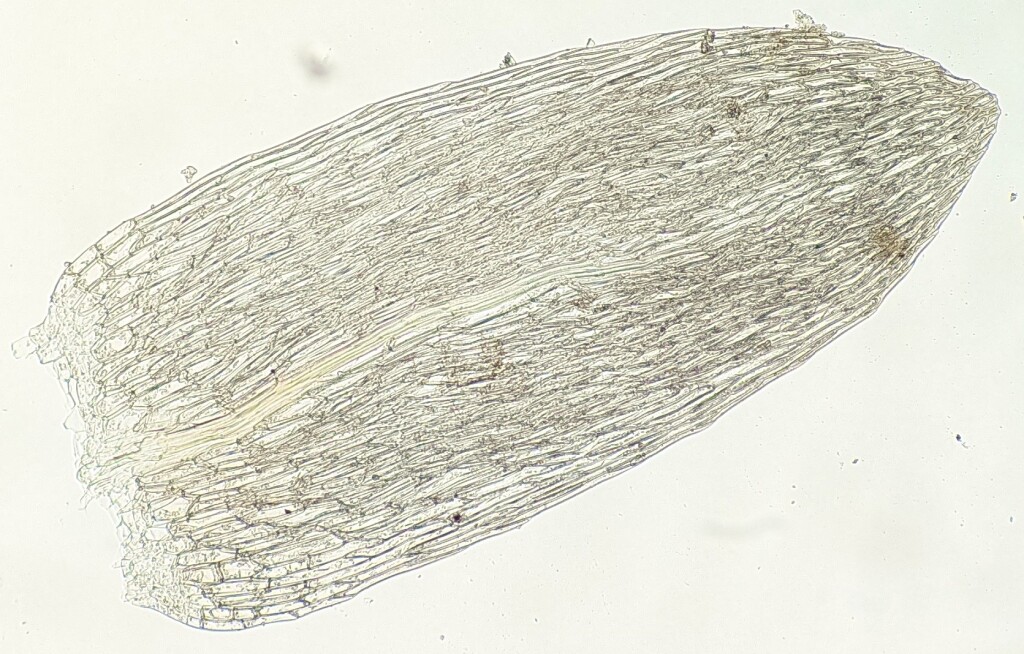Ochiobryum
Dioicous. Asexual reproduction by rhizoidal tubers (not in Victoria). Dense tufts on rocks. Stems simple or sparingly branched by innovation, julaceous, with rhizoids near base; central strand present. Leaves oblong or ovate (not in Victoria) to lanceolate (not in Victoria), imbricate and erect to erect-spreading when moist or dry, often complanate; apex rounded to acute; costa subpercurrent, percurrent or excurrent (not in Victoria); margin entire or denticulate near apex (not in Victoria), plane or recurved, with or without (not in Victoria) a border of more elongate cells; laminal cells rhombic or hexagonal (not in Victoria), becoming quadrate or rectangular toward base, or elongate throughout, smooth. Capsule inclined to pendent (not in Victoria), obovate or ovate to pyriform, with a persistent or caducous annulus. Operculum conic, apiculate. Peristome double; endostome equal height as exostome, with basal membrane 50–65 % of exostome height; cilia present.
Around three species, but genus limits uncertain (see below); one species in Victoria.
Spence & Ramsay (2005) described Ochiobryum, based on the Victorian Bryum blandum Hook.f. & Wilson. This species, along with another two species form a well-supported group in phylogenies of chloroplast DNA sequences (Cox & Hedderson 2003; Pederson et al. 2003; Pedersen & Hedenäs 2005). This group of three species were described as Imbribryum prior to description of Ochiobryum (Pedersen & Hedenäs 2005). However, Imbribryum was invalidly published because a type species was not designated. This mistake was corrected (Pedersen 2005), but shortly after the description of Ochiobryum. Consequently, Ochiobryum is the correct name to be used if these three species are defined as a genus as is followed here.
These three species are morphologically heterogeneous, with presence or absence of a distinct leaf border, laminal cell shape and how cell shape changes toward the base, and whether rhizoidal tubers can be produced, varying between these species. Additionally, some phylogenetic analyses suggest that some species here included in Bryum, like B. sauteri Bruch & Schimp. and B. tenuisetum Limpr., may be closer related to Ochiobryum (Pedersen et al. 2007), which would further obscure the boundaries between the two genera. Consequently, the validity of this genus requires further scrutiny. The circumscription of Ochiobryum proposed by Spence & Ramsay (2005) and treated by Spence & Ramsay (2006) did not include the two non-Victorian species included in the invalid Imbribryum, but they did include another non-Australian species and suggest other putatively related species, whose relationships to O. blandum have not yet been confirmed with molecular phylogenetics.
 Spinning
SpinningCox, C.J.; Hedderson, T.A.J. (2003). Phylogenetic relationships within the moss family Bryaceae based on chloroplast DNA evidence. Journal of Bryology 25: 31–40.
Pedersen, N. (2005). Validation of Imbribryum (Bryaceae). The Bryologist 108: 449.
Pedersen, N.; Cox, C.J.; Hedenäs, L. (2003). Phylogeny of the moss family Bryaceae inferred from chloroplast DNA sequences and morphology. Systematic Botany 28: 471–482.
Pedersen, N.; Hedenäs, L. (2005). Taxonomic and nomenclatural implications of phylogenetic studies of the Bryaceae based on molecular data and morphology. The Bryologist 108: 123–128.
Pedersen, N., Holyoak D.T.; Newton, A.E. (2007). Systematics and morphological evolution within the moss family Bryaceae: A comparison between parsimony and Bayesian methods for reconstruction of ancestral character states. Molecular Phylogenetics and Evolution 43: 891–907.
Spence, J.R.; Ramsay, H.P. (2005). New genera and combinations in the Bryaceae (Bryales, Musci) for Australia. *Phytologia * 87: 61–72.
Spence, J.R.; Ramsay, H.P. (2006). Bryaceae, in McCarthy, P.M. (ed.), Flora of Australia. Vol. 51 Mosses 1, pp. 274–348. ABRS, Canberra.



